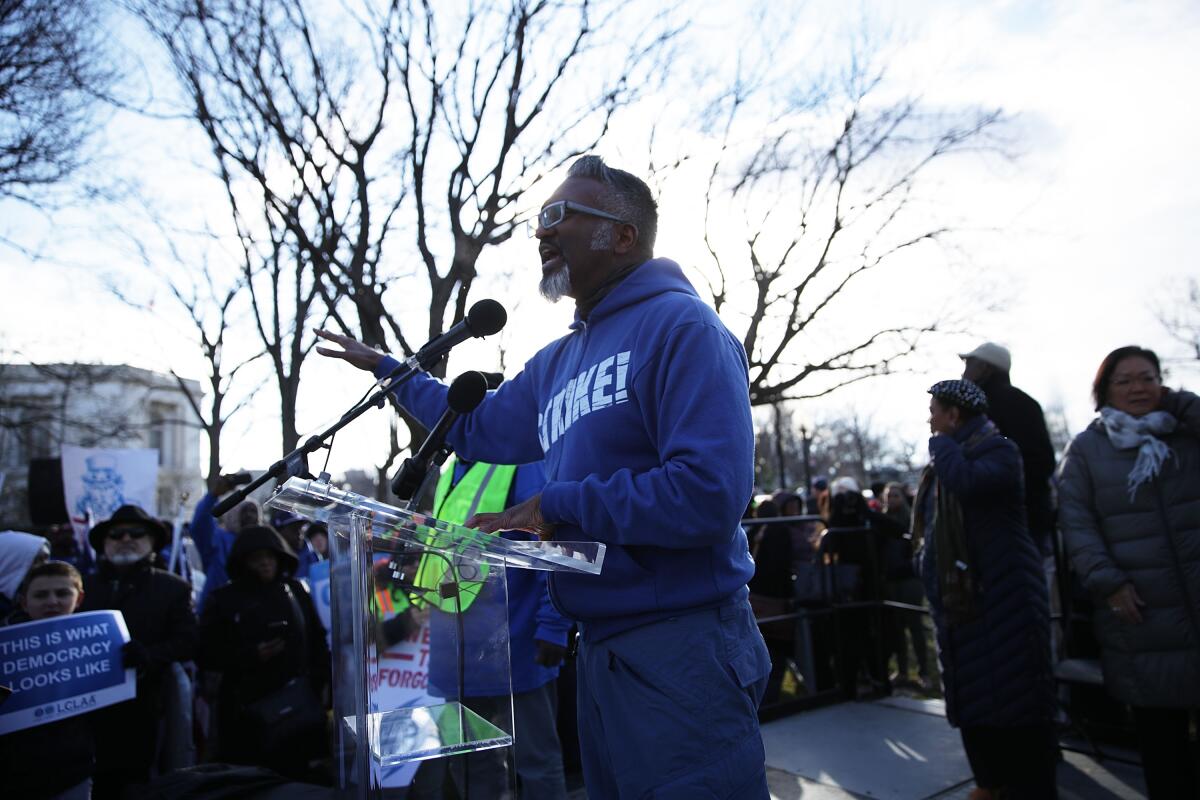No honeymoon: Activists on the left prepare for a possible Biden presidency

WASHINGTON — It was the early days of Barack Obama’s presidency, and the left was eager to work with a president who had campaigned like a progressive and, years before, even worked as a community organizer.
Their enthusiasm wouldn’t last.
At the time, Joseph Geevarghese was helping to lead a labor coalition. He repeatedly met with an Obama administration task force on middle-class families, headed by Vice President Joe Biden, and pressed it to support a $15-an-hour federal minimum wage and other pro-labor initiatives. But Biden’s team was adamant, he recalled — they couldn’t, or wouldn’t, do it.
“That first-term experience was incredibly disheartening and frustrating,” Geevarghese said. “We had invested troops and treasure, and had incredible hope that change would come with a progressive, quote-unquote, president. But we didn’t get anywhere.”
Now, with Biden leading preference polls nationally and in crucial battleground states in his own bid for the White House, activists on the left are poised, if he’s elected, to be more aggressive from the start in pressing their agenda. They talk of a strategy that combines insider politicking with outside agitation — the sort of demonstrations by fast food workers, Walmart employees and Los Angeles port truck drivers that brought pressure to bear on the Obama-Biden administration by its second term.
Within a Biden administration’s first 100 days, Geevarghese said, there would need to be a “mass mobilization” of progressives: “There is not going to be a honeymoon period.”
His words reflect the impatience of the political left, which for months has stifled its demands of the Biden campaign to make common cause with it in defeating President Trump. Its favored candidate, independent Vermont Sen. Bernie Sanders, himself endorsed Biden months ago, and members of the Sanders bloc have collaborated with Biden’s campaign in “unity task forces.” But they say they’re not letting him off the hook past the election.
“Bernie has been very clear that after the election ... we’re going to hold Biden’s feet to the fire on his progressive commitments that he has made,” said Faiz Shakir, a senior advisor to Sanders. For example, he said, Biden “has made some pretty solid commitments” on climate policy, including to invest in clean energy and green public housing.
Geevarghese is now executive director of Our Revolution — the organizing group that emerged from Sanders’ 2016 Democratic presidential campaign. He thus personifies a broader coalescing of the left around the democratic-socialist agenda of Sanders’ 2016 and 2020 presidential bids.
Maikiko James of Los Angeles recalled joining the Democratic Socialists of America “right after the election of Donald Trump in 2016, and did what many of us did” — looked up the meaning of “democratic socialism.”
James, who now serves on the national political committee of Democratic Socialists of America, was not alone. The organization’s membership tripled in the year around Trump’s election, continued to grow during his presidency and surged once again amid the COVID-19 pandemic — although with about 71,000 members, it remains small.
Even so, it has enjoyed some high-profile successes, including the elections of left-wing Democratic Reps. Alexandria Ocasio-Cortez of New York and Rashida Tlaib of Michigan in 2018, and, this year, the Democratic primary victories of House candidates Jamaal Bowman of New York and Cori Bush of Missouri, both of whom are all but certain to be elected Nov. 3.
But while progressive activists and their allies in Congress would be trying to push a President Biden to the left, Democrats from swing districts and states that may lean Republican would be pressing him to be moderate. Biden himself has run on a less ambitious agenda than Sanders and other Democratic challengers did, eschewing proposals like “Medicare for all” and a Green New Deal for less bold initiatives.
When asked how they’d achieve their progressive goals despite these obstacles, many organizers offered a two-pronged approach: working on both the inside and the outside.
For examples of the inside game, Shakir cited efforts to get Biden to put progressives in key administration positions and to reflect progressive values in his initial agenda.
David Kim, a progressive mounting an uphill challenge against Democratic Rep. Jimmy Gomez for the Los Angeles-area 34th Congressional District seat, said that Kamala Harris could be a potential ally in the White House as vice president. Despite her more moderate, prosecution-oriented record on criminal justice, Kim said, the positions she took during her own presidential campaign suggest an openness to progressive ideas.
For many on the left, however, insider politics and mainstream political institutions have little appeal. The idea of pursuing change primarily at the ballot box has long been criticized by activists and ideologues on the left; they favor continued mobilization, organizing and exerting pressure on public officials between elections.
“Voting is the bare minimum of what we should all be doing,” said James.
“I’ve always regarded electoral politics as a racket,” said Shahid Buttar. Yet now the progressive is running for office himself — a likely quixotic race to unseat Speaker Nancy Pelosi in her San Francisco district. “Bernie showed me how to do it right — how electoral politics can serve social movements and help build them instead of sapping the energy from them,” he said.
But Buttar’s strategy extends to support for sit-ins, Occupy-style protests and, in particular, general strikes. “When we withhold labor en masse, we have influence that we can’t in any other way,” he said.
In some sense, such activism has been underway nationwide since the spring, when the Black Lives Matter movement sparked widespread protests against police brutality and for racial justice through strikes, occupations, walkouts, marches and rallies.
“Why was it that really fresh leaders, not the old people looking for their next job, managed to ignite people over that?” asked Jonathan Tasini, a writer and former union leader who’s been a surrogate for Sanders. “How did those tactics [work] and how does that inform how we might confront the Biden administration?”
For Steve Paul, a Sanders delegate to the 2020 Democratic convention and an organizer with the civic-engagement organization One Pennsylvania, the continued threat of police brutality demonstrates the inadequacies of relying on elected officials alone for change.
“Electing Barack Obama as president of the United States did not stop police from killing our people in the streets, so electing a president alone is not going to solve Black people’s issues,” Paul said.
For now, the Democratic Party remains in more moderate hands, and an administration led by Biden and Harris isn’t likely to alter that much. While some on the left are strategizing about how to engage with and influence a Biden administration, many are skeptical that the party establishment will even offer them a seat at the table.
“The very first thing [will be] to abandon the pretense that it’s working with us,” said Buttar. Many on the left acquiesced to that same pretense during Obama’s early years, he said, leaving the Democratic president feeling less pressure from progressives and reacting more to demands from the right.
Today, after two Sanders campaigns and a summer of protests, left-wing activists express little interest in repeating such concessions to the Democratic Party’s powers that be.
“We cannot just be satisfied with having meetings [and] being invited to the White House social events,” Geevarghese said. “We’re going to have to be militant, and in the streets.”
More to Read
Get the L.A. Times Politics newsletter
Deeply reported insights into legislation, politics and policy from Sacramento, Washington and beyond. In your inbox three times per week.
You may occasionally receive promotional content from the Los Angeles Times.











